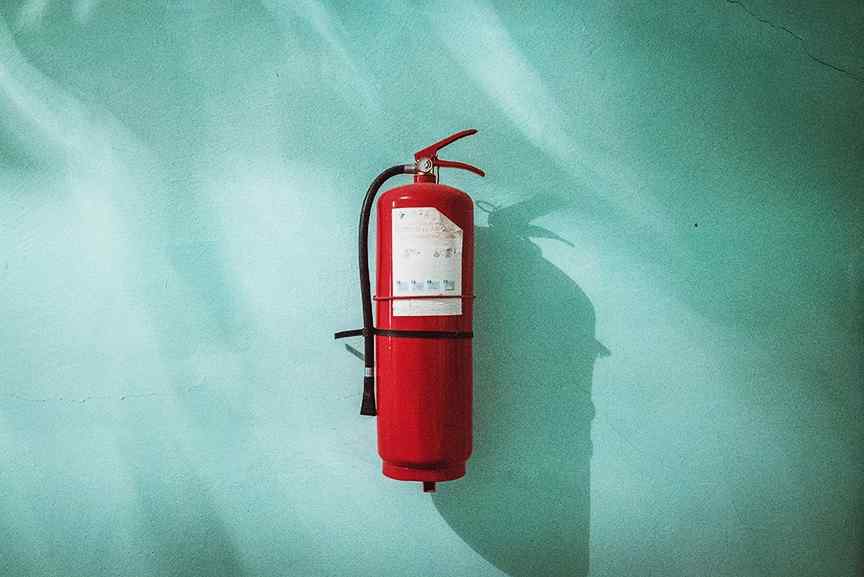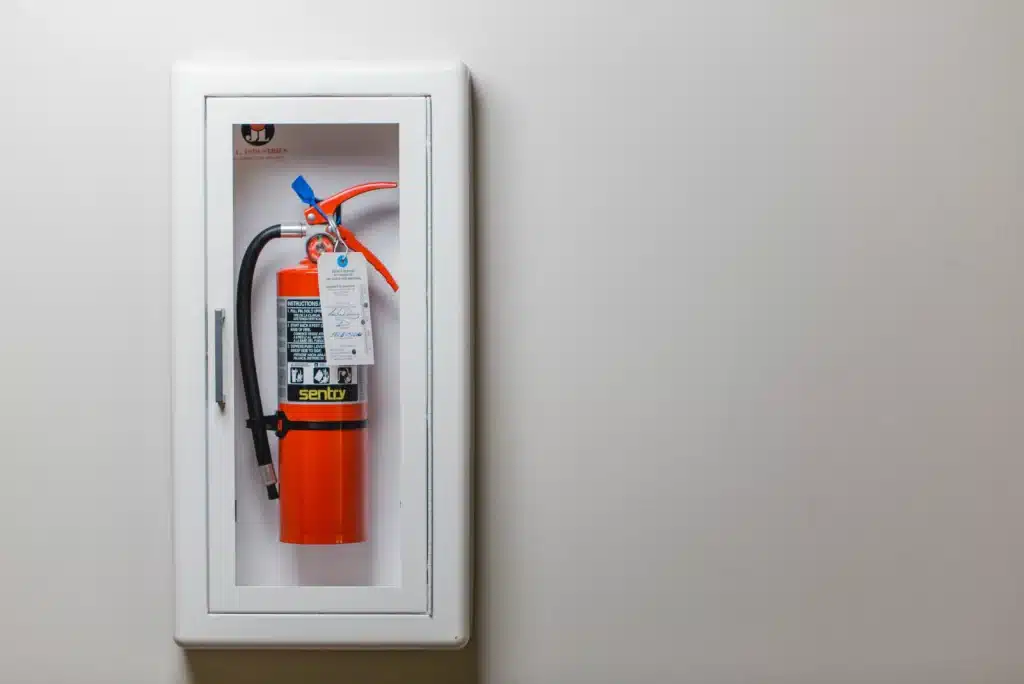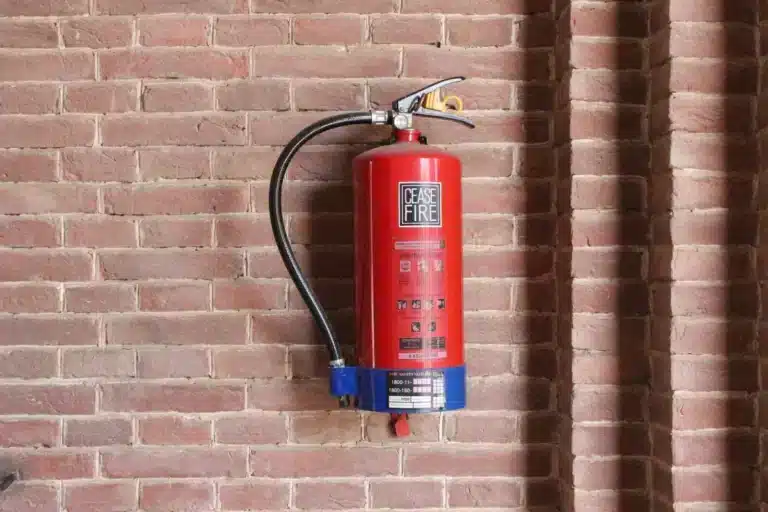Introduction
What Is Inside A Fire Extinguisher: While the outer appearance of a fire extinguisher may vary, the internal components remain relatively consistent across different types and models. Pressurized containers are composed of steel or aluminum to resist high pressures. Extinguishers need the extinguishing agent and propellant, which it contains. The extinguisher’s propellant forces out the extinguishing substance.
The extinguishing agent is the substance contained within the fire extinguisher that suppresses or extinguishes the fire. The extinguisher’s agent varies on the fire type. Different types of fires require different extinguishing agents, such as water, carbon dioxide, dry chemical powders, foam, or specialized agents like halon or clean agents. Inside the fire extinguisher, there are various mechanisms and components that enable its proper operation. These include a valve assembly, a pressure gauge, a safety pin or tamper seal, a discharge nozzle or hose, and an operating lever or handle. Each component serves a specific purpose, allowing the user to activate and control the flow of the extinguishing agent.
Understanding the internal components of a fire extinguisher is crucial for its maintenance and proper usage. Regular inspections and servicing ensure that the extinguisher remains in good working condition, guaranteeing its reliability during emergencies. It is also important to be familiar with the specific instructions and guidelines provided by the manufacturer for the particular type of fire extinguisher in order to use it effectively and safely.

What gas is inside a fire extinguisher?
Carbon dioxide is incombustible and also does not support burning. Hence, it is used in fire extinguisher. When sprayed on burning object it stops the supply of oxygen and extinguishes fire.
Carbon Dioxide (CO2)
Carbon dioxide is a colorless, odorless, and non-flammable gas commonly used in fire extinguishers. It works by displacing oxygen, thereby suffocating the fire. CO2 extinguishers are suitable for Class B (flammable liquids) and Class C (electrical) fires. They are commonly found in laboratories, server rooms, and areas with electrical equipment.
Dry Chemical Powders
Dry chemical powders extinguish many fires. They are stored under pressure and discharged as fine powder when the extinguisher activates. Monoammonium phosphate, sodium bicarbonate, and potassium bicarbonate are dry chemical powders. These extinguishers work on Class A, B, and C fires.
Water
Class A wood, paper, and textile fires are often extinguished with water. Heat-removal pressurized water extinguishers control flames. Their usage on flammable liquid, electrical, or cooking oil flames might spread the fire or pose electrical concerns.
Foam
Foam extinguishers contain a mixture of water and a foaming agent. When activated, the foam forms a blanket that suppresses the fire by cooling and smothering it. Foam extinguishers are suitable for Class A and Class B fires, making them useful in areas with flammable liquids, such as fuel storage areas, warehouses, and garages.
What is extinguisher filled with?
USC uses “ABC” fire extinguishers with fine yellow powder. This powder is mostly monoammonium phosphate. The extinguishers are pressurized with nitrogen.
Environmental concerns have led to the decline of halon extinguishers. The residue-free halon suppresses Class A, B, and C flames. FM-200 and Novec 1230 replace halon and offer similar capabilities while being ecologically friendly.
B (flammable liquids) and C (electrical) fires. Gas displaces oxygen, suffocating the flames. Since they leave no trace or harm, extinguishers are utilized in electrical and sensitive locations.
They come in various formulations, including monoammonium phosphate, sodium bicarbonate, and potassium bicarbonate. Dry chemical powder extinguishers work by interrupting the chemical reactions that support combustion. They are effective against Class A, Class B, and Class C fires.
Discharged foam blankets the fire, separating it from oxygen and reducing heat. Warehouses and fuel storage locations with volatile substances employ foam extinguishers for Class A and Class B fires.
The extinguishing agent in these extinguishers reacts with the hot cooking oil, creating a soapy foam that cools the oil and forms a barrier to prevent reignition. Wet chemical extinguishers are commonly found in commercial kitchens and restaurants.
What liquid is in fire extinguisher?
Extinguishers in water can be potassium acetate, potassium carbonate, potassium citrate, or a combination. The liquid is often acidic. Extinguishers employ FM-200 and Novec 1230. Pressure turns liquids into gases. Waterless Class A, B, and C flame cleanup. Cleaners stop fire heat and chemical reactions.
Selecting the right extinguisher for fire dangers is vital. Learn extinguisher types and uses. Inspect and maintain Keep the extinguisher supplied and operating.
Water extinguishers target Class A flames like wood, paper, and fabrics. Pressurized water from the extinguisher cools flames below the sparking point.
Do fire extinguishers expire?
Here are the two NFPA fire extinguisher life expectancy guidelines every business owner or facility manager should know: Replace disposable fire extinguishers every 12 years. Rechargeable fire extinguishers every 6 years.
Fire extinguisher cylinders, valves, and hoses can corrode or wear out over time. The extinguisher may become less reliable or hazardous due to structural damage. Inspections and maintenance can detect corrosion and wear and determine extinguisher replacement.
The extinguishing agent or propellant inside a fire extinguisher can degrade over time, rendering it less effective in suppressing fires. For example, certain dry chemical powders can cake or harden, reducing their ability to discharge properly. Additionally, certain clean agents may have specific shelf lives due to their chemical properties. It is important to follow the manufacturer’s guidelines and recommendations regarding the lifespan and replacement of the extinguishing agent.
Leaks or steady discharge can lower fire extinguisher pressure. The loss of pressure can affect the extinguisher’s performance and its ability to expel the extinguishing agent effectively. Regular pressure checks and inspections are necessary to ensure that the extinguisher is maintaining the required pressure. If pressure losses are high, the extinguisher may need service or replacement.Fire safety technology advances, creating more efficient and advanced fire extinguishers.
Can we extinguish fire with water?
Water is useful to extinguish fire. Water puts out fire by creating a barrier between the fuel source and the oxygen source.Water cools flammable material below ignition temperature. The Water has the nature to extinguish fire.
Cooling Effect
Water is highly effective in cooling fires. Water cools a fire by absorbing heat from the flames. This cooling effect helps to break the fire’s chain reaction by lowering the temperature below the level required for sustained combustion. It also prevents the fire from spreading to nearby combustible materials.
Heat Absorption
Water has a high heat absorption capacity. It requires a significant amount of heat energy to raise its temperature, which means that water can absorb a substantial amount of heat from a fire. By absorbing heat from the fire, water helps to remove the fire’s heat source, leading to the suppression and extinguishment of the flames.
Smothering
In addition to cooling, water can smother. When poured in sufficient quantities, water can block fuel and air oxygen, smothering the fire. This starves the fire of oxygen, extinguishing it.
Limitations
While water is highly effective for Class A fires, it may not be suitable for all types of fires. In Class B or C fires with flammable liquids or electricity, do not use water. Water can spread flammable liquids, making the fire worse, and it can conduct electricity, posing a risk of electrical shock. It is important to understand the type of fire and use the appropriate extinguishing agent accordin
Can you refill a fire extinguisher?
You can only refill rechargeable fire extinguishers. Your professional provider may charge $20–$50 to recharge.
Check fire extinguishers before refilling. Test extinguishers routinely. Do not refill rusted, damaged, or leaky extinguishers. Refilling fire extinguishers requires authority certification. Certified professionals must evaluate and provide solutions.
The proper fire class agent must be added to fire extinguishers. Mixing incompatible substances can cause harmful or inefficient reactions. Fill the extinguisher with the manufacturer-recommended agent and concentration.
Some fire extinguishers need pressure recharges as well as agent refills. Refilling the pressure cylinder ensures proper agent discharge when activated. Specialized equipment and educated people are needed to replenish pressure.
Refilling a fire extinguisher in good condition that meets all refilling standards can be cheaper than buying a new one. It’s crucial to compare the cost of refilling to a new extinguisher, as refilling can be expensive, especially for older or rare types.
Do fire extinguishers freeze?
Water and foam extinguishers stored outdoors or in unheated spaces may freeze and destroy their internal lining. Protecting extinguishers against freezing temperatures is crucial since they may become worthless in a fire.
Fire extinguishers contain pressurized contents, which can include water or other liquids. When exposed to extremely low temperatures, these liquids can freeze. The freezing point of the liquid depends on its composition. For example, water freezes at 0 degrees Celsius (32 degrees Fahrenheit). Therefore, fire extinguishers containing water as an extinguishing agent are particularly susceptible to freezing.
Many fire extinguishers are stored outside or in unheated places. In cold climates or during winter seasons, the ambient temperature can drop below freezing, potentially causing the contents of the extinguisher to freeze. Exposure to freezing temperatures for an extended period can damage the extinguisher and compromise its functionality.
Freezing can render a fire extinguisher ineffective. Freezing water in a fire extinguisher prevents it from doing its job. This can hinder the extinguisher’s fire suppression and control. Fire extinguishers must be kept above freezing.
Freezing can also cause damage to the internal components of a fire extinguisher. When liquids freeze, they expand, which can result in the rupture or deformation of the extinguisher’s container, valve, or other parts. This can lead to leaks or loss of pressure, rendering the fire extinguisher unusable and requiring repairs or replacement.
Are all fire extinguishers rechargeable?
There are essentially two types of fire extinguishers: rechargeable and disposable. You can check which kind you have by checking the gauge. Rechargeable ones will read either “charge” or in the green, “overcharge” or “recharge,” and disposable ones will read “full” or “empty.”
Many fire extinguishers are rechargeable. Extinguishers usually have a metal cylinder, valve assembly, and removable cap or head. Trained personnel can recharge extinguishers and pressure. The ability to replenish and service rechargeable fire extinguishers makes them long-lasting.
Non-refillable fire extinguishers exist. Plastic or non-metallic extinguishers are common. Discharged extinguishers cannot be recharged. If refilling is impractical or expensive, disposable fire extinguishers may be better.
Fire extinguisher rechargeability depends on agent kind. Water extinguishers can be refilled because water is abundant. Environmental or safety issues may prevent refilling Halon-like extinguishers. The manufacturer’s instructions will explain if and how to recharge the extinguisher.

Conclusion
Fire extinguisher training teaches individuals about the different types of fires, the appropriate extinguishing agents for each type, and the proper techniques for using a fire extinguisher. This knowledge equips individuals with the skills and confidence needed to respond quickly and effectively in fire situations.
Moreover, understanding the limitations of fire extinguishers is crucial. While they can be highly effective in extinguishing small fires, they may not be sufficient for larger or more hazardous fires. In such cases, it is essential to prioritize personal safety and evacuate the area while alerting professional firefighters.
Regular maintenance and inspections are critical to ensuring that the inside fire extinguisher remains in optimal working condition. Visual checks, pressure tests, and timely refills or replacements are essential to guaranteeing the reliability and functionality of the device. Inspect and maintain fire extinguishers according to local fire authority or regulatory body standards.
Fire extinguishers, combined with proper training, contribute to a comprehensive fire safety plan and can make a significant difference in minimizing damage and saving lives. By understanding the components, receiving training, and regularly maintaining fire extinguishers, individuals can enhance their ability to respond effectively in fire emergencies, promoting a safer environment for themselves and those around them.

